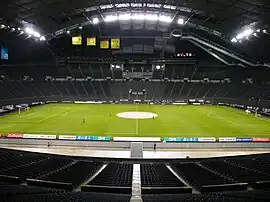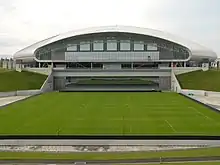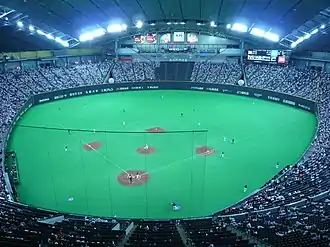43°0′54.7″N 141°24′35.3″E / 43.015194°N 141.409806°E
Hiroba | |
 | |
 | |
| Location | Hitsujigaoka 1, Toyohira-ku, Sapporo, Hokkaido, Japan |
|---|---|
| Public transit | Sapporo Municipal Subway: |
| Owner | Sapporo City |
| Operator | Sapporo Dome Co.,Ltd. |
| Capacity | 42,065 (football)[1] 42,270 (baseball)[2][3] |
| Field size | Left Field – 100 m (328.1 ft) Center Field – 122 m (400.3 ft) Right Field – 100 m (328.1 ft) Backstop – 25 m (82 ft) Height of Outfield Fence – 5.75 m (18.9 ft)  |
| Construction | |
| Opened | June 3, 2001 |
| Architect | Hiroshi Hara |
| Tenants | |
| |
Sapporo Dome (札幌ドーム, Sapporo Dōmu) is a stadium located in Sapporo, Hokkaido, Japan, and is primarily used for association football. It is the home field of the association football club Hokkaido Consadole Sapporo, and was also home to the baseball team Hokkaido Nippon-Ham Fighters through the 2022 Nippon Professional Baseball season. It was a football venue for the 2020 Summer Olympics,[4] was the venue for the opening ceremony of the 2017 Asian Winter Games, and was used for two matches of the 2019 Rugby World Cup.[5] The stadium was previously a venue of the 2002 FIFA World Cup. The dome will be used as the venue for the opening and closing ceremonies of the 2030 Winter Olympics if Sapporo is successful in their bid.
History

Sapporo Dome opened in 2001 with 41,580 seats. The stadium hosted three games during the 2002 FIFA World Cup, Germany vs Saudi Arabia, Argentina vs England and Italy vs Ecuador; all three matches were in the first round.
The Dome hosted the opening ceremonies of the 2007 FIS Nordic World Ski Championships on February 22 and hosted the closing ceremonies of the championships on March 4. It also made history as being the first venue where both indoor and nighttime skiing events took place for the first time on a world championship or Winter Olympic Games level with competitions in the cross-country skiing sprints (men's and women's individual, and men's and women's team) and the cross-country portion of the 7.5 km sprint event in the Nordic combined. In order to generate snow, the stadium used its turf conversion hovering system to facilitate the snow making process for the skiing competitions.[6] The opening ceremony featured Maki Ohguro, a local artist from Sapporo, Japanese drum demonstrations and other performances paying tributes to local customs and traditions.[6] For the championships, seating capacity was reduced to 30,000.[6]
The Dome was used as a super special stage in Rally Japan in both 2008 and 2010.
In late 2009, renovations with the possibility of increasing the capacity up to 53,796 were finished. These renovations also included space for more food outlets, an extra video screen, two extra changing rooms (to accommodate preseason matches in the NFL International Series, which have up to 75 players per team) and further media area as part of new office buildings attached to the stadium. As part of these renovations, the surface area of the arena itself was decreased to allow for more seating.
Beginning in 2023, the dome will be soccer-only, as the Fighters will move into their own new stadium in nearby Kitahiroshima.
Retractable surface
The Dome switches between two entirely different surfaces: Baseball games are played on an underlying artificial turf field, while association football games are held on a grass pitch that slides into and out of the stadium as needed.
Conversion from baseball to football begins with the storage of the baseball field's artificial turf. Once finished, a set of lower bowl bleachers rotate from an angled position for baseball to a parallel position. A set of main bowl seats on one end of the dome then retracts, and the football pitch is slid into the stadium. The lower bowl is then rotated 90 degrees. Conversion from football to baseball occurs in reverse. Due to the retraction of seats, the Stadium has a capacity of 40,476 for baseball games.
Other stadiums that feature sliding pitches include the GelreDome in the Netherlands, Veltins-Arena in Germany, State Farm Stadium in Glendale, Arizona, United States, and Allegiant Stadium in Paradise, Nevada, United States, along with the split pitch of London's Tottenham Hotspur Stadium and Madrid's Santiago Bernabéu Stadium, ; however, unlike these facilities (with the exception of Allegiant Stadium), the Sapporo Dome has a fixed roof.
 Retractable grass field shown outside the stadium
Retractable grass field shown outside the stadium Football field installed inside the stadium, during a football match.
Football field installed inside the stadium, during a football match. Inside the stadium during a baseball game.
Inside the stadium during a baseball game.
Details
- Name: Sapporo Dome
- Capacity: 42,065 / 40,476
- Home Team: Hokkaido Consadole Sapporo
- Former home team: Hokkaido Nippon-Ham Fighters (2004–2022)
- Completed: March 2001
- Location: Sapporo City, Hokkaido, Japan
- Building Area: 53,800 m2 Total Floor Area:(Open Arena) 92,453 m2
- Roof Diameter: 245 m Stand Inclination: Max. 30° angle
- Winter heating: Gas[7]
- Architect: Hiroshi Hara
Access
- Tōhō Line: 10 minutes walk from Fukuzumi Station.
Major sports matches
2002 FIFA World Cup
| Date | Team 1 | Result | Team 2 | Round (A, B, C, D...) | Attendance |
|---|---|---|---|---|---|
| 1 June 2002 | 8–0 | Group E | 32,218 | ||
| 3 June 2002 | 2–0 | Group G | 31,081 | ||
| 7 June 2002 | 0–1 | Group F | 35,927 |
2019 Rugby World Cup
| Date | Time (JST) | Team #1 | Result | Team #2 | Round | Attendance |
|---|---|---|---|---|---|---|
| 21 September 2019 | 13:45 | 39–21 | Pool D | 36,482 | ||
| 22 September 2019 | 19:15 | 35–3 | Pool C | 35,923 |
See also
Other domed stadiums in Japan:
- Fukuoka Yahoo! Japan Dome in Fukuoka (retractable roof)
- Nagoya Dome in Nagoya
- Kyocera Dome Osaka in Osaka
- Ōita Stadium or "Big Eye" in Oita Prefecture (retractable roof)
- Tokyo Dome in Tokyo
References
- ↑ "FIFA Women's World Cup 2023: Bid Evaluation Report" (PDF). FIFA. 10 June 2020. pp. 177–178. Retrieved 7 June 2023.
- ↑ "ヤフオクドーム大規模改修で最大収容4万人超え 4球場が大台に/デイリースポーツ online".
- ↑ "Sapporo Dome". sapporo-dome.co.jp. Retrieved 13 November 2011.
- ↑ "Venue Plan". Tokyo 2020 Bid Committee. Archived from the original on 27 July 2013. Retrieved 11 September 2013.
- ↑ "Matches". World Rugby. Archived from the original on 11 June 2020. Retrieved 17 September 2019.
- 1 2 3 FIS Newsflash Edition 112. January 31, 2007.
- ↑ Takai, Hiroaki (2014). Planning outline and analysis of actual energy operational performance from completion to present in Japanese and foreign large domes and stadiums — Tokyo Dome, Fukuoka Dome, Odate Dome, Sapporo Dome, Kaohsiung Stadium (PDF). World Sustainable Building. p. 454. ISBN 978-84-697-1815-5.
External links
- (in English) Dome website Archived 2020-05-02 at the Wayback Machine
- (in English) World Stadiums — Stadium Design — Sapporo Dome Stadium in Sapporo
_2020.jpg.webp)
